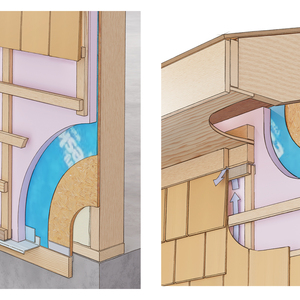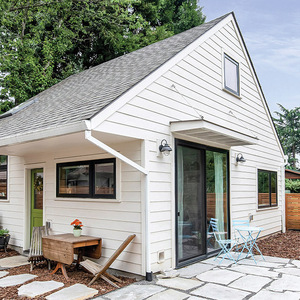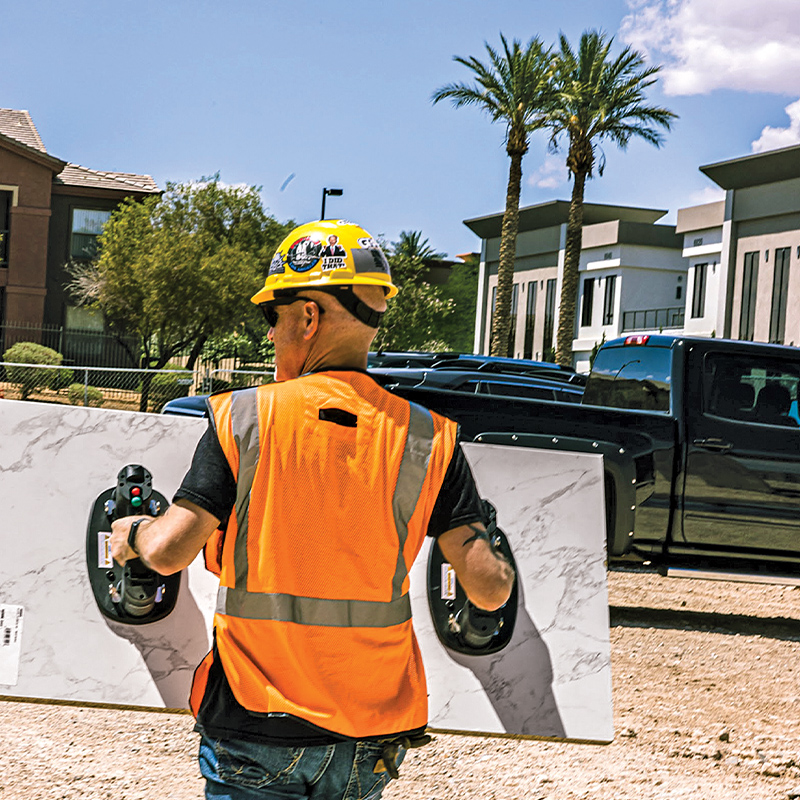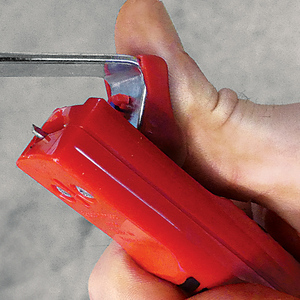Twice now I have encountered complaints of lights flickering on residential circuits with 1960’s/70’s era Zinsco subpanels with aluminum bus bars. Lights would blink now and then, TV would shut down (voltage spike protector circuit?) and in one case, a touch-on/off lamp would randomly turn itself on. In one unit the panel was in a dimly lighted hallway and I could actually see, through gaps between breakers, flashes from arcing.
Breakers all were in good shape and showed no sign of damage to the contacts, but the aluminum bus bars were pitted and eroded and coated with nasty deposits of aluminum oxide from arcing.
Instead of tearing out the wall in order to fit a new and bigger box I spent 20 minutes returning the old one to near-new condition.
Those old Zinsco duplex breakers contact each of the busbars at a different level, so swapping the bus bars from left to right puts new metal under the breaker contacts.
All I had to do was to shut off power at the meter, disconnect both feed wires, pull off all of the breakers (allowing them to hang from their wires), pull the two mounting screws from the bonding bar assembly that also holds the bottom end of the bus bars, and slip them out. I then polished the metal a little with steel wool, put the original left bar in the right slot, right in left slot, connected the feed wires, pushed the breakers back in place and put the cover back on.
If the buildings are still standing in 30 more years when arcing damage has happened again, the next guy can replace the box – I’ll be 90 years old and won’t care anyway.
BruceT




















Replies
Pretty good idea you got there. Mine did the same thing. I didn't even try that. I just changed it out. My thinking at the time was If I have one 220 breaker go bad then I can cover the cost of the new panel. $80.00 at the time. I had previously lost one 15 amp breaker and when I put in my hot tub I had to get a new double pole breaker. I had scrounged them up at work so I got lucky. But the cost would have been pretty steep if I had to pay for them.
Anyway that was my thinking at the time. That and the fact that I do it for a living so it was no big deal.
Rock the Tipi!
I cannot agree with this idea, for a couple of reasons.
First of all, in the course of damaging the bussbars, the heat will also damage metal nearby- damage that may not be particularly visible. So, the "fix" probable won't last 30 years.
Second, the heat will also damage the breakers. Since we have no reliable way to tell if a breaker will continue to trip when it should, the breakers should be replaced. This brings us to...
Third. The breakers are no longer manufactured. Ones offered for sale are expensive, and are "reconditioned," no longer UL listed (even if the marks are present).
There are other reasons to consider a new panel, as well as an over-all upgrade to the wiring.
Old panels often have too few breakers for the necessart circuits. For example, since Zinsco went to the "great scrapyard in the sky," we've come to recognise a need for at least two kitchen circuits. An old house will often have problems with breakers tripping, as too many appliances are used at once.
Obtaining GFI breakers can be difficult for Zinsco- and Arc faults impossible.
Finally, sale of the property, and insuring it, will be harder with an obsolete panel.
....yeah, ......what you said..
.
.
.Wer ist jetzt der Idiot
?
Yeahhh.. . . . . you should have seen my zinsco. 5 mainst to flip before you got all the power off, space for about 15 circuits (I'm now up to 34 on my new panel), etc. etc.
You may be right if there's nothing else wrong with the house wiring, but if you're going to work on the rest of the house wiring, I think it makes sense to go ahead and upgrade the panel.
zak
"so it goes"
I agree with Renosteinke, Maddog and Zak, that old places are under-wired by todays standards, but for a single woman in a 900sq foot townhouse, I think re-wiring the place to provide multiple circuits in the kitchen and additional circuits in other rooms would not be worth the cost.As for Zinsco replacements being re-conditioned, I know that they used to be, but there is at least one company making new replacement breakers for Zinsco panels.I inspected all of the breakers before putting them back in the panel and there was no sign of heat damage to cases or contacts and all of them were capable of shutting off and then restoring power to their respective circuits. Is there a safe and reliable way to test a breaker's functionality under actual overload conditions? I suppose I could plug a bobby pin into an outlet, but I don't think I want to :)BruceT
The reason that the UL listing is no longer valid on reconditioned equipment is that there is NO industry standard way to test an individual breaker, to ensure that it will trip when it is supposed to. UL tests of new breakers actually destroy the breakers; an assumption is made that identical assemblies, made under identical circumstances, will perform the same. This is validated by quality controls and the testing of random samples. It just is not possible to do this with used equipment- you have no idea where the stuff has been. Likewise, there are new breakers manufactured as replacements to obsolete ones, but virtually all of these are not UL listed. The recent floods, etc., have brought to light 'hidden damage' that may occur in electrical equipment. The fact is, everything wears out... and electrical panels are no exception. Too expensive to change out a panel? Compare the price of a proper "service change" to what you pay for a new roof, or to remodel the bathroom- both tasks routinelt done to older homes. Just because the wiring is not as visible as the new countertop does not mean it's any less important.
for other members in this forum i will let you know that i dealt with alot of zinsco breaker box as well.
myself I do know Renosteinke very well i keep in touch with him pretty often ,,
anyway many zinsco breaker box is very diffucalt to repair espcally with bussbar burn up and pitted in alum bussbar and many time breaker concat do get weak over the time and it will actally fail.
how fast it will fail hard to say but overloading get them pretty hot and short circuits ?? humm you are pretty much on your own because the zinsco dont trip very well at all even a overload it will not trip at all.
i have quite few service calls related to this and many time i strongly recomoned to replace the box with more modern set up because the cost of repalcement breaker is getting to the point where it not even worth [ beepped ] a thing. and many hardware store only stock very limited items and those repalcement breakers are genrally not UL listed at all
and other thing with Zinsco breakers some of the house wiring is pretty well cooked as well [ just the point before it start the fire ]
i think there is a link i dont rember where it was and they have class action lawsuit going on but i dont have the facts with me with lawsuit going on.
all i care is the safety for the homeowner safety sake here
for other peoples if you have a Zinsco breaker box Please do call a real electricican and they will take a look and give you the price to replace the breaker box to safe manner
i done this alot before the cost i just cant tell you because each area the cost will varies alot and also the local code issuse will show up as well
Merci, Marc
Master Electrician
Thanks Renosteinke and Cap for your answers to the question about testing breakers. I had assumed that there wouldn't be much to go wrong with a breaker, especially since they are called upon to trip very rarely. In 35 years living in my house I have had to re-set a breaker only a handful of times, so other than turning them off and on deliberately, most of them have never had to do anything. So this brings up other questions. Renosteinke said "The fact is, everything wears out... and electrical panels are no exception." If a breaker trips once or twice in 35 years, what wears out? Should I be suspicious of the condition of breakers in my 35-year old Square-D combination meter and service panel box?CAP said, "There is a UL-listed test instrument that measures the magnetic response of a 15 or 20 amp brach circuit breaker." Should I get a licensed electrician to run this test on that Zinsco box or even on my own Square-D?Is it true that you should cycle all breakers off/on annually to keep them mechanically free to trip when needed?Thanks for taking time on this.BruceT
Edited 7/2/2006 11:06 am ET by BruceT999
I have not heard of regular flipping of breakers as a practice, but see no harm in it. Breakers do contain contacts, springs, and sundry little parts. Most will trip from at least two separate causes- usually heat, and magnetism (created by current passing through). Heat can change the behavior of springs, contacts can be damaged by arcing, and everything can be affected by corrosion or grit that interferes with movement. This is where lots of folks in New Orleans are going to get "bit." After the flood, many are using breakers that look, on the surface, to be clean. Give them a few years, however, and those breakers are not going to be reliable. In a similar manner, you can be sure that lots of replaced breakers are going to turn up in the "reconditioned" market. Again, lets look at the costs involved. New breakers usually cost under $5. Obsolete ones, $20. You don't have to buy many obsolete breakers to exceed the cost of a new panel.
>>I have not heard of regular flipping of breakers as a practice, but see no harm in it.
A fairly common maintenace suggestion; I believe the manufacturers recommend it once a year.
Bruce,
It's a very common maintenance practice; cycle each breaker two or three times once a year to exercise the mechanical linkage and redistribute the grease on the piviot points. Have spare breakers handy (or be prepared to go get 'em) if a breaker won't close and hold. I've learned this the hard way...
Keep in mind that when a breaker trips under a short circuit type fault, the arcing takes a toll on the contact points. And when there's an overload that causes a trip, there's wear on the breaker too--the bimetallic strip that overheats, bends, and causes the breaker to open is designed for only so many cycles. The point is, if a breaker trips more than a few times (on either short or overload conditions), it ought to be replaced.
Unfortunately, in a lot of instances where a breaker trips, the resident or occupant will try to reset the breaker several times without addressing the cause of the trip. With an overload, they may get it to close (for a while). It's only when the breaker fails open, that an electrician is called. If it fails closed, the fire department usually gets the first call, then the electrician.
There are only a couple of brands of breakers (FPE two-pole in particular) that have a documented fail-secure problem. Most of the time, if a breaker fails, it fails safe--i.e., open and can't be closed.
You could have the breakers tested with the KO breaker tester. Not many professional electricians have the tester, so you might have to hunt for someone who can do the testing.
Actually, there's little need for concern with a Square-D panel that has Square-D breakers in it. Square-D breakers have an excellent reputation for reliability, and their short circuit response is one of the best (quickest). Square-D (the QO line) is expensive, and you get what you pay for.
Based on my experience, on a Zinsco panel with 30-year-old breakers, I'd expect at least one breaker in 20 will fail the test. Does this make the building unsafe? Not necessarily, if the fixed wiring is all properly installed and maintained.
As far as the safety of the electrical system, if the branch circuit wiring is questionable, the best thing to do is to evaluate it with a voltge drop tester, fix it up, and add circuits as needed to alleviate overloads. That may necessitate replacing the panel to accomodate more circuits.
This brings up the whole topic of the safe working life of fixed building wiring. People generally assume that building wiring lasts forever. For instance, knob and tube wiring can continue to serve 70 years on, if installed correctly, not improperly modified, and never overstressed. Those three conditions are rarely met.
The NFPA (the folks who publish the NEC and other Codes) is conducting a study on how building wiring ages. They've actually cut sections of walls out of buildings and taken them back to the lab to dissect and test them. I'll visit the website and report back what the status and findings are to date. The website is http://www.NFPA.org, but be advised that the full results of most studies are are generally accessible to members only.
Cliff
There is a UL-listed test instrument that measures the magnetic response of a 15 or 20 amp brach circuit breaker. It drops a dead short across the circuit and measures trip current and time to trip. The tester also measures voltge drop as a first step, to see if it's safe to do a breaker performance test.
The manufacturer is KO Instruments. They have a website.
The tester isn't cheap. By that I mean it's over a k-buck. But it's the only safe way to actually test breaker response for mag trip (i.e., dead short conditions).
I've found that about 5-7 percent of vintage zinsco breakers fail the magnetic response test. These are breakers that will manually cycle and otherwise appear O.K. Makes it pretty easy to make the case for a panel replacement.
Cliff
Is there any test of the thermo trip on the breaker?IIRC it is not untill you get to around 6-9 times rated current until the magnetic trip controls.I don't have any statistcal information about the details of electrical problems that cause fires, but you often here "caused by overload spacing heaters". Now I would suspect that they are more typically overloaded by much less than would take for the magnetic trip to activate.
Bill,
No tester for overload trip testing that I know of.
And you're right, the fault current on short circuit can reach many times the breaker rating before the breaker opens. Some breaker brands have higher set points than others.
It's interesting using the KO breaker tester--seeing a current of 250 to 300 amps for 100 to 200 milliseconds--on a 20 amp breaker that's functioning properly. The tester is programmed to stop the test if the current goes too high or for too long.
When I test breakers, I advise the client that there's a small but real risk of blowing apart a weak splice in the circuit. Not that that's a bad thing, it exposes a weak point, but it's gonna cost money to find and fix it, and they need to know that.
I've tested circuits in commercial occupancies, with wire run in conduit, where the high short circuit current causes the wires to slap around violently in the conduit and make quite a racket.
I believe that a lot of the fires reported as electrical causes by the general press are due to appliances or cords, i.e., not the fixed building wiring. And most of the fires actually caused by fixed wiring are due to improper use of materials (like using lamp cord as fixed wiring, or overfusing) or substandard techniques (like flying and/or improperly made splices).
Cliff
The cautions mentioned are all worth considering.
Keep in mind that a contractor has additional concerns in such situations:
Which is cheaper, trepalcement or refurbishing? At today's labor prices, usually replacement
"Last Guy In" syndrome: the last guy/gal to work on a component has "bought it" in the sense that any future problems will probably be blamed on her/him.
Personally, I'd live with Fed Pac breaker box, butr not a Zinsco in the condition you described, even as "refurbished.
With all due respect to the OP, I just strongly disagree. We aren't exactly talking big money to replace the panels. If the buss is pitted, simply moving the breakers around is simply not advisable. Ask this question, would the UL approve this repair? No way. There is also another issue not address here, the gutter space is insufficient by today's standards putting undue stress on the wires.
Bottom line is replacement is the only recommendable option considering the expense to risk considerations.
http://www.ableinspector.com
Bruce L.
Do you realize you're responding to a thread that is 6 years old? All those people are long gone.
Zinsco Power panel
Where is the master breaker for the Zinsco power panel. Apparently I do not have one in the power panel itself. The panel is rated at 150 AMPs
There is a "master breaker"
There is a "master breaker" somewhere. If the panel doesn't have one then it's upstream somewhere -- in the "main" panel, if this is a subpanel, or at the "service entrance".
Amazon, Home Depot etc. now offer replacement copper bus bars with plating...
https://www.homedepot.com/p/Connecticut-Electric-125-Amp-Type-RBK-UBI-Replacement-Buss-Bar-Kit-for-Zinsco-Load-Centers-UBIZRBK12/100669974